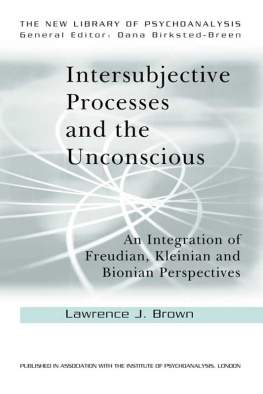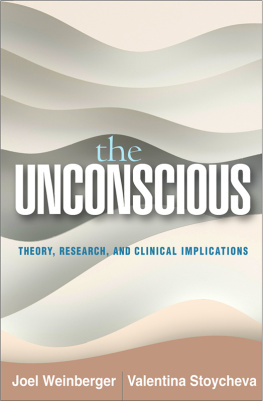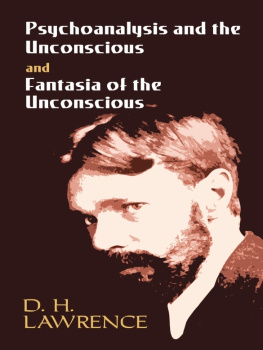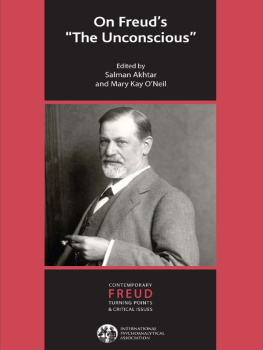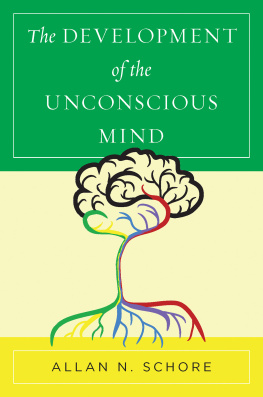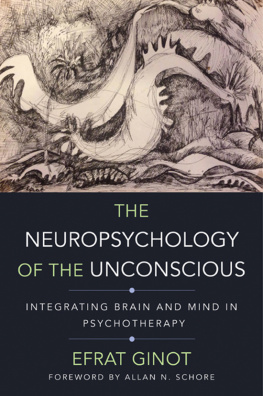
NEW LIBRARY OF PSYCHOANALYSIS
General Editor: Dana Birksted-Breen
Intersubjective Processes and the Unconscious
An Integration of Freudian, Kleinian and Bionian Perspectives
Lawrence J. Brown

First published 2011
by Routledge
27 Church Road, Hove, East Sussex BN3 2FA
Simultaneously published in the USA and Canada
by Routledge
270 Madison Avenue, New York, NY 10016
Routledge is an imprint of the Taylor & Francis Group, an Informa Business
Lawrence J. Brown 2011
All rights reserved. No part of this book may be reprinted or reproduced or utilised in any form or by any electronic, mechanical, or other means, now known or hereafter invented, including photocopying and recording, or in any information storage or retrieval system, without permission in writing from the publishers.
This publication has been produced with paper manufactured to strict environmental standards and with pulp derived from sustainable forests.
British Library Cataloguing in Publication Data
A catalogue record for this book is available from the British Library
Library of Congress Cataloguing in Publication Data
Brown, Lawrence J., 1946
Intersubjective processes and the unconscious : an integration of Freudian, Kleinian, and Bionian perspectives / Lawrence J. Brown.
p. cm. (New library of psychoanalysis)
Includes bibliographical references and index.
ISBN 9780415606998 (hardback : alk. paper)
ISBN 9780415607001 (pbk. : alk. paper) 1. Psychoanalysis.
2. Subconsciousness. 3. Klein, Melanie. 4. Bion, Wilfred R. (Wilfred Ruprecht), 18971979. 5. Freud, Sigmund, 18561939. I. Title.
BF173.B833 2010
150.195dc22
ISBN: 9780415606998 (hbk)
ISBN: 9780415607001 (pbk)
Introduction
No one who, like me, conjures up the most evil of those half-tamed demons that inhabit the human breast, and seeks to wrestle with them, can expect to come through the struggle unscathed.
(Freud, 1905a, p. 109)
This book represents an attempt to explore the nature of intersubjective processes from a particular theoretical framework an integration of primarily Freudian, Kleinian, and Bionian perspectives that typically has not been associated with the terms intersubjectivity or intersubjective. However, I will argue that embedded in these traditions are theoretical and clinical stances that describe and offer the reader a deep understanding of the nature of intersubjective processes, which in their essence are unconscious in nature. These processes are extraordinarily complex and, operating under the radar of conscious awareness, rapidly engage the psyches of analyst and patient in the creation of a jointly constructed narrative that either removes the cloak of repression from forgotten memories or ascribes meaning to experience for which no language previously existed.
I will begin with a brief, though highly condensed, vignette that quickly came to mind when I sat before my computer and started to gather my thoughts for the project before me. I immediately thought about a poignant session from the analysis of a young boy I treated a few years ago. In addition to the powerful emotions evoked in the analytic hour, I also felt a sense of many disparate thoughts, writings, and personal experiences about intersubjectivity suddenly falling into place as though a kaleidoscopes fragments had unexpectedly taken the form of a stained-glass design. It became clear that, as Beebe, Knoblauch, Rustin, and Sorter (2004) have said, there are many forms of intersubjectivity, and yet it seemed that all these were present in the encounter with Sam.
Sam, 4 years old, was in analysis for aggressive behavior at home and school. His mother was regularly overwhelmed by his behavior and struggled to set appropriate limits, often feeling like a single parent because her husband was frequently very depressed. Sams father was a fragile man who had been hospitalized for depression on numerous occasions, and the family tended to walk on eggshells around him. Despite what appeared to be an inability to control his anger, Sam showed a remarkable capacity to rein himself in while with his father. He was often provocative with me, and his play consisted of repetitive variations on aggressive themes.
Sam began the session in a typical manner, dumping all the dinosaurs and action figures onto the analytic couch, which was the arena for battle. Gradually we each gathered an army and then arranged the figures according to fighting skill. As usual, Sams fighters easily trounced mine, and I was left feeling predictably demoralized. I repeated some of the interpretations of this play that addressed how my men had all the losing feelings that felt really bad and made them angry, and that his men were lucky to be so strong and have all the exciting winning feelings. Sam shrugged his shoulders and said, unimpressed, yeah, I guess.
At one point I decided to withdraw my men to the desk a few feet away, saying that they needed a break. As I moved my pieces to the desk I noticed that there was an incoming telephone call, and the caller ID indicated that it was from the hospital in New York where my mother was then a patient. I immediately became quite worried, since she was very ill with congestive heart failure. I am not sure what my expression looked like, nor do I know how long I was actively distracted. Nevertheless, I quickly came out of my distraction and said, probably with a somewhat forced exuberance, Ok, lets get back to the battle! However, Sam said that he wanted to play something different, and he introduced a theme that had never previously appeared. He said that he was going to be a mummy, and I heard mommy. Mommy? I asked, and he corrected me, No, mummy you know those creepy guys with the bandages wrapped all over them and pretended to have unraveled, ragged gauze dropping off him. I dismissed my mishearing him as an artifact of worry about my mommy and let the play unfold.
Sam said that the mummy had to be buried, lifted up the couch mattress, and began to inter himself between the mattress and the wooden slats it rested on. I was a bit disoriented, in the midst of what felt like an uncanny experience (Freud, 1919). I said something about how dead mummies are buried in a grave just like he was showing me and thats very scary and sad. Sam quickly replied that this mummy wasnt really dead; it was an alive mummy that used to be dead. I was relieved at hearing this, though I was not aware in the moment why it affected me this way. I said, when a mummy that used to be dead becomes alive again the people who love that mummy arent so scared and sad anymore. Now in an excited state, he went over to the desk drawer where the supplies are kept, took out a roll of scotch tape, and asked that I wrap him in it so he could be like a real mummy.
This very brief, but complex, vignette is a multilayered intersubjective precipitate of the interaction between Sam and me that occurred on conscious, preconscious, and unconscious levels. Though this book will explore such intersubjective exchanges on all planes of consciousness, it is my belief that intersubjectivity is based upon, and is largely comprised of, processes that are a constant unconscious companion to what is occurring on a conscious level. The session begins with a repetitive game of competition and defeat that left me feeling consciously demoralized, which I interpreted with the comment about the losing feelings being in me. However, on this particular day, for reasons of which I was unaware at that moment, I withdrew from the play to my desk. Why on this particular day was I unable to tolerate the demoralized and losing feelings? In retrospect, my receptivity to these emotions was most likely curtailed by worries about my mother that were lurking preconsciously and left me closed to losing feelings. My telephone emits an almost imperceptible clicking sound when a call is coming in, and, although I was not aware of hearing that, it must have registered an alarm that brought me to my desk rather than stay with Sam. Thus, on this particular afternoon, there was a unique alignment of conscious, preconscious, and unconscious events that defined a singular moment in a fleeting emotional field that Sam and I shared.
Next page
